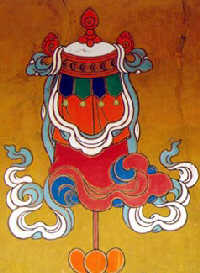Eight Sacred Buddhist Symbols
7. Lotus flower (padma) - as the flower rises from muddy roots, so Nirvana arises from this shabby world; therefore it symbolizes purity.
8. Banner of Victory (dpal-be) - a unique Buddhist object, the cylindrical layered banner symbolizes victory over ignorance and death.
The eight auspicious symbols of Tibetan Buddhism consist of: a parasol, a pair of fishes, a treasure vase, a lotus, a white-spiraling conch shell, an endless knot, a victory banner, and a golden wheel.
Groupings of eight auspicious symbols were originally used in India at ceremonies such as an investiture or coronation of a king. An early grouping of symbols included: a throne, a swastika, a handprint, a hooked knot, a vase of jewels, a water libation flask, a pair of fishes, and a lidded bowl.
In Buddhism, these eight symbols of good fortune represent the offerings made by the gods to Shakyamuni Buddha immediately after he gained enlightenment. The following expounds upon these symbols.
The Parasol (umbrella): This was a traditional Indian symbol of protection and royalty. The parasol denoted wealth and status - the more included in a person's entourage, the more influential the person was, with 13 parasols defining the status of king.
Indian Buddhists who saw the Buddha as the universal monarch adopted this concept. Besides, 13 stacked parasols form the conical spire of the Buddha or Tathágata stupa. In Buddhist mythology, the king of the nagas (serpent-like creatures) gave a jeweled umbrella to the Buddha.
Symbolically, the protection provided by the parasol is from the heat of suffering, desire, obstacles, illness, and harmful forces.
A typical Tibetan parasol consists of a thin round wooden frame with 8, 16, or 32 thinly arched wooden spokes. Through its center passes a long wooden axle-pole embellished at the top with a metal lotus, a vase, and the triple jewel. White, yellow, or multicolored silk stretches over the domed frame and a folded or pleated silk skirt with 8 or 16 hanging silk pendants attached hang from the circular frame. The parasol dome represents wisdom and the hanging skirt, compassion.
The Two Golden Fishes: The two fishes originally represented the two main sacred rivers of India - the Ganges and the Yamuna. These rivers are associated with the lunar and solar channels that originate in the nostrils and carry the alternating rhythms of breath or prana (life-sustaining force).
Fish have religious significance in Hindu, Jain, and Buddhist traditions as well as in Christianity (the sign of the fish, the feeding of the five thousand). In Buddhism, the fish symbolize happiness as they have complete freedom of movement in the water. They represent fertility and abundance. They are often drawn in the form of carp, which are regarded in Asia as sacred on account of their elegant beauty, size, and lifespan.
The Treasure Vase: This is known as "the vase of inexhaustible treasures" - however much is removed from it, the vase remains perpetually full. In Southwest China's Tibet Autonomous Region, wealth vases sealed with precious and sacred substances are commonly placed upon altars and on mountain passes, or buried in water springs. The symbol is often shown as a highly ornate, traditional-shaped vase with a flaming jewel or jewels protruding from its mouth.
The Lotus Flower: The lotus blossoms unstained from the watery mire; it is a symbol of purity, renunciation, and divinity.








